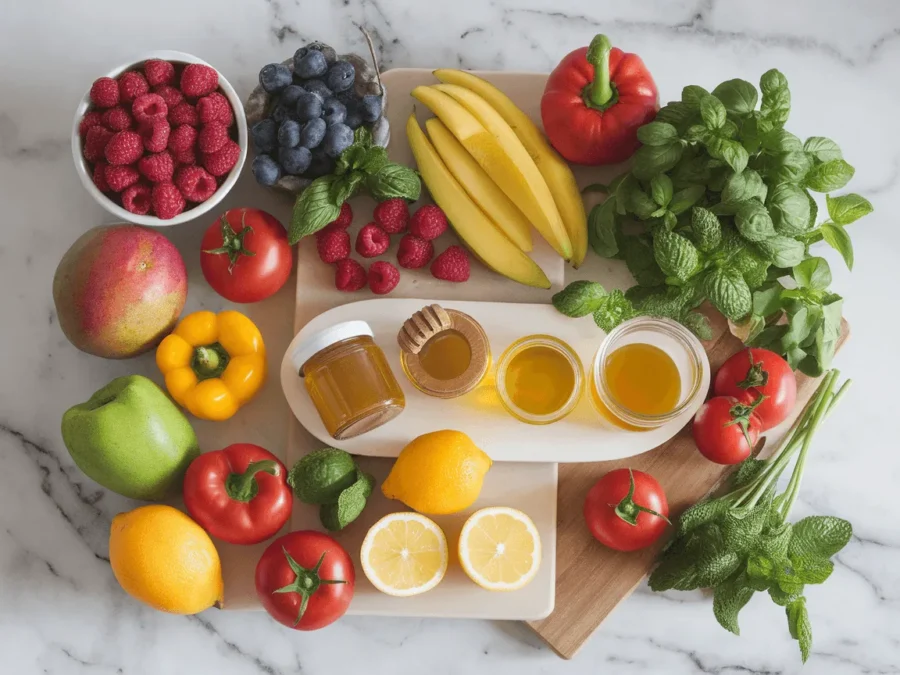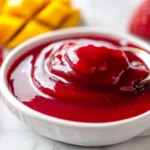Whether you’re drizzling it over a decadent dessert or spooning it alongside a savory dish, coulis is the secret weapon that can elevate any meal. This silky, flavorful sauce isn’t just for professional chefs it’s easy to make at home, incredibly versatile, and a true game-changer in the kitchen. Let’s dive into the delicious world of coulis and uncover everything you need to know to master
Table of Contents
What is Coulis? An Introduction to the Classic Sauce
Coulis (pronounced koo-LEE) is a simple yet elegant sauce made from pureed fruits or vegetables. Its texture is smooth, and its flavors are bold and concentrated. Whether sweet or savory, coulis can enhance both the look and taste of a dish, making it a favorite among chefs and home cooks alike.
Origins and History
Coulis has its roots in French cuisine, where it was originally used as a thick sauce for meats and fish. Over time, the term evolved to include fruit-based sauces for desserts. In its modern form, coulis embodies the French culinary principle of enhancing natural flavors while keeping things beautifully simple.
“Coulis is the little black dress of sauces versatile, timeless, and always impressive.”
Coulis vs. Puree: What’s the Difference?
At first glance, coulis and puree might seem interchangeable. Both involve blending ingredients into a smooth consistency, right? Not quite. Here’s the key difference:
- Coulis: Always strained to achieve a velvety texture, free of any pulp or seeds.
- Puree: Thicker and unstrained, often used as a base for soups or baby food.
Think of coulis as the refined sibling of puree sleek, smooth, and polished to perfection.
Types of Coulis: Sweet, Savory, and Beyond

One of the best things about coulis is its adaptability. Whether you’re working with fruits, vegetables, or even herbs, you can whip up a coulis to complement nearly any dish.
Sweet Coulis: Perfect for Desserts
Sweet coulis is often made from fruits like berries, mangoes, or peaches. Here’s where it shines:
- Raspberry coulis: A tangy-sweet companion to cheesecakes and chocolate cakes.
- Mango coulis: Tropical and vibrant, perfect for panna cotta or ice cream.
- Strawberry coulis: A classic choice for drizzling over pancakes, waffles, or yogurt.
Sweet coulis is all about showcasing the fruit’s natural flavor, with minimal added sugar to keep it fresh and lively.
Savory Coulis: Ideal for Main Dishes
On the savory side, vegetable-based coulis can add depth and color to main courses. Popular options include:
- Tomato and basil coulis: A zesty topping for grilled chicken or pasta.
- Red pepper coulis: Smoky and rich, great with roasted fish or lamb.
- Spinach coulis: A vibrant green sauce that pairs beautifully with poached eggs or salmon.
Savory coulis allows you to experiment with bold, unexpected flavor combinations that transform ordinary dishes into culinary masterpieces.
Creative Variations: Adding a Twist to Traditional Coulis
Why stop at the basics? Coulis is a blank canvas for creativity. Try these ideas:
- Add a splash of balsamic vinegar to strawberry coulis for a sweet-tangy balance.
- Mix roasted garlic into a tomato coulis for extra richness.
- Blend herbs like cilantro or parsley into vegetable coulis for fresh, herbal notes.
“The beauty of coulis lies in its ability to adapt whether you’re feeling traditional or adventurous, there’s a version for you.”
The Essential Ingredients for a Perfect Coulis

You don’t need a laundry list of ingredients to make coulis. In fact, its simplicity is what makes it so appealing.
Choosing the Right Fruits for Sweet Coulis
When it comes to fruit-based coulis, freshness is key. Opt for ripe, juicy fruits that are naturally flavorful. Here are some tips:
- Berries: Go for raspberries, strawberries, or blackberries they’re naturally vibrant and easy to blend.
- Tropical fruits: Mangoes and passionfruit bring bold flavors and bright colors.
- Stone fruits: Peaches and apricots work beautifully when their natural sweetness is highlighted.
Frozen fruits can also work in a pinch, especially when fresh options aren’t in season.
Vegetables and Herbs for Savory Coulis
For savory coulis, look for vegetables with bold flavors and vibrant colors:
- Tomatoes: Opt for ripe, meaty varieties like Roma or heirloom.
- Bell peppers: Roasting them first enhances their natural sweetness.
- Carrots: Their earthy sweetness makes them a surprising but delightful option.
Add fresh herbs like basil, thyme, or cilantro to enhance the flavor profile of your savory coulis.
Using Quality Liquids and Flavor Enhancers
Liquids like water, stock, or juice help achieve the right consistency, while small amounts of sugar, salt, or lemon juice enhance the flavor. Think of these as the glue that ties the coulis together:
- Sweet coulis benefits from a touch of honey or maple syrup.
- Savory coulis shines with a splash of olive oil or vinegar.
Step-by-Step Guide to Making Coulis
Creating a perfect coulis at home is easier than you might think. With just a few tools and a handful of fresh ingredients, you can whip up this silky sauce in no time. Follow these simple steps to master the art of coulis.
Basic Tools and Equipment You’ll Need
To make coulis like a pro, you’ll need some basic kitchen equipment. Fortunately, these tools are common in most households:
- Blender or food processor: Essential for achieving a smooth consistency.
- Fine-mesh strainer or sieve: Key for removing seeds and pulp, giving your coulis that velvety texture.
- Small saucepan: Useful for simmering ingredients to intensify flavors.
- Spatula or spoon: For pressing the mixture through the strainer.
Pro tip: If you don’t have a blender, a hand immersion blender works just as well!
Preparing Ingredients for Maximum Flavor
The secret to a great coulis lies in preparation. Here’s how to get the most out of your ingredients:
- Wash thoroughly: Rinse fruits or vegetables under cold water to remove dirt and debris.
- Peel and chop: Remove skins (if necessary) and chop into smaller pieces to blend easily. For example, peel mangoes or remove the seeds from bell peppers.
- Sweeten or season: Depending on whether you’re making sweet or savory coulis, add a pinch of sugar, salt, or other flavor enhancers.
Cooking, Blending, and Straining Coulis Like a Pro
Here’s where the magic happens:
- Cook (if needed):
For savory coulis or fruits that require softening (like rhubarb), simmer your ingredients with a splash of liquid until they’re tender. This step also helps to concentrate flavors.- For example, cook tomatoes with garlic and olive oil for a savory base.
- For a fruit coulis, simmer berries with a bit of water and sugar to break them down.
- Blend:
Transfer the cooked or raw ingredients to your blender or food processor. Blend until smooth. - Strain:
Pour the blended mixture through a fine-mesh strainer. Use a spatula to press the coulis through, leaving seeds, pulp, and any fibrous bits behind. - Adjust consistency:
If your coulis is too thick, add a splash of liquid (water, stock, or juice) and mix until it reaches your desired texture. - Taste and tweak:
Adjust the seasoning add a touch more sugar, a squeeze of lemon juice, or a pinch of salt as needed.
“Think of your coulis as a blank canvas taste, adjust, and let your creativity shine!”
Common Problems When Making Coulis and How to Solve Them
Even with a simple recipe, things can sometimes go awry. Let’s troubleshoot some common issues you might face when making coulis.
Thin or Watery Coulis: Causes and Fixes
A coulis that’s too thin might lack the luxurious texture you’re aiming for. Here’s how to fix it:
- Cause: Using too much liquid during blending.
- Solution: Simmer the coulis on low heat to reduce and thicken it naturally. Alternatively, add a thickening agent like cornstarch (for sweet coulis) or a dollop of tomato paste (for savory coulis).
Overly Sweet or Bland Coulis: How to Adjust Flavors
Coulis that’s too sweet or lacks punch can be disappointing. Here’s what to do:
- Too sweet? Add a squeeze of lemon or lime juice to balance the flavors.
- Too bland? Enhance sweetness with honey or sugar for fruit coulis, or add salt and herbs for savory versions.
“A well-balanced coulis should make your taste buds dance not overwhelm them!”
Achieving the Perfect Texture and Consistency
If your coulis feels grainy or lumpy, it’s likely due to insufficient blending or straining. Always blend thoroughly and take the time to strain properly. This extra effort ensures a smooth, professional-quality sauce.
How to Use Coulis in Your Recipes
Once you’ve mastered making coulis, it’s time to put it to good use. Coulis isn’t just a garnish it’s a flavor enhancer that can transform your dishes from ordinary to extraordinary.
Pairing Sweet Coulis with Desserts
Sweet coulis is a natural match for desserts. Try these ideas:
- Cakes: Drizzle raspberry coulis over cheesecake or pound cake for a pop of color and tanginess.
- Ice cream: Swirl mango coulis into vanilla ice cream for a tropical twist.
- Breakfast treats: Use strawberry coulis to elevate pancakes, waffles, or French toast.
Imagine dipping a spoon into a rich chocolate cake, only to taste the vibrant burst of berry coulis it’s pure bliss!
Enhancing Savory Dishes with Vegetable Coulis
Savory coulis can elevate your entrees by adding color, moisture, and depth of flavor. Some delicious pairings include:
- Grilled meats: Tomato-basil coulis pairs wonderfully with steak or chicken.
- Roasted vegetables: A drizzle of red pepper coulis adds a smoky finish to roasted squash or zucchini.
- Seafood: Spinach coulis brings out the delicate flavors of poached salmon or seared scallops.
Coulis as a Garnish: Tips for Presentation
Coulis isn’t just about flavor it’s about presentation, too! Use a squeeze bottle or spoon to create artistic drizzles, dots, or swirls on the plate. It’s a small touch that makes a big impact.
Storing and Preserving Coulis for Future Use
One of the best things about coulis is that you can make it ahead of time. Proper storage not only extends its shelf life but also preserves its vibrant flavors. Whether you’re saving it for a few days or prepping for a special occasion, here’s how to store coulis like a pro.
Refrigeration: How Long Does Coulis Last?
When stored in an airtight container, coulis stays fresh in the refrigerator for up to 3–5 days. Be sure to let the coulis cool to room temperature before sealing it. This prevents condensation, which could water down your sauce.
For added freshness:
- Label the container with the preparation date.
- Store it on a middle or lower shelf, where the temperature remains stable.
Pro tip: If your coulis starts to develop a sour smell or changes in color, it’s time to toss it.
Freezing Coulis: Tips for Best Results
Need your coulis to last longer? Freezing is your best bet! Here’s how:
- Use ice cube trays: Pour coulis into an ice cube tray and freeze until solid. Once frozen, transfer the cubes to a freezer bag or container. This method allows you to thaw only as much as you need.
- Avoid overfilling containers: Coulis expands slightly when frozen, so leave a little room at the top of your container.
- Thaw properly: When ready to use, thaw the coulis in the refrigerator overnight. If it separates after thawing, a quick stir or blend will restore its silky texture.
Frozen coulis can last up to 3 months without losing flavor or quality.
Signs That Your Coulis Has Spoiled
Even with proper storage, coulis can go bad. Watch out for these warning signs:
- A sour or off-putting smell.
- Discoloration (e.g., fruit coulis turning brown).
- Mold forming on the surface or lid.
“When in doubt, throw it out!” Freshness is key to keeping your dishes vibrant and delicious.
Popular Recipes Featuring Coulis

Ready to put your coulis to work? These recipes showcase its versatility, from sweet to savory, and will impress even the pickiest eaters.
Classic Raspberry Coulis Recipe
Raspberry coulis is a timeless choice for desserts. Here’s how to make it:
Ingredients:
- 2 cups fresh or frozen raspberries
- 1/4 cup granulated sugar
- 1 tablespoon lemon juice
Instructions:
- Combine raspberries, sugar, and lemon juice in a small saucepan. Cook over medium heat, stirring occasionally, until the berries soften and release their juices (about 5–7 minutes).
- Transfer to a blender and purée until smooth.
- Strain through a fine-mesh sieve to remove seeds.
- Serve immediately or store for later use.
Perfect for: Cheesecake, panna cotta, or as a topping for Greek yogurt. 🍰✨
Tomato and Basil Coulis for Pasta and Meats
This savory coulis adds a burst of Mediterranean flavor to any meal.
Ingredients:
- 4 ripe Roma tomatoes, chopped
- 1 garlic clove, minced
- 1/4 cup fresh basil leaves
- 2 tablespoons olive oil
- Salt and pepper to taste
Instructions:
- Heat olive oil in a saucepan and sauté garlic until fragrant. Add tomatoes and cook until they break down into a chunky sauce (about 10 minutes).
- Blend the mixture with fresh basil until smooth.
- Strain if desired, and season with salt and pepper.
Perfect for: Drizzling over grilled chicken, pasta, or even as a pizza sauce alternative.
Exotic Mango Coulis for Tropical Desserts
Bright, fruity, and irresistible mango coulis is a showstopper.
Ingredients:
- 2 ripe mangoes, peeled and diced
- 2 tablespoons honey
- 1 tablespoon lime juice
Instructions:
- Blend mangoes, honey, and lime juice until smooth.
- No cooking required! Strain for extra smoothness if needed.
Perfect for: Ice cream, pavlova, or tropical fruit salads. 🥭💛
FAQs
Curious about coulis? Here are some common questions and answers to help you perfect your sauce game.
Can I Make it Without a Blender?
Yes, you can! If you don’t have a blender, use a food processor or even a hand masher for soft fruits. For a super-smooth texture, make sure to strain the mixture thoroughly after mashing.
What’s the Best Way to Strain it?
A fine-mesh sieve is your best tool for straining coulis. Place the sieve over a bowl and pour in your blended mixture. Use the back of a spoon or spatula to press the liquid through, leaving behind seeds and pulp.
Tip: For large batches, consider investing in a chinois strainer, which is designed for sauces and soups.
Can it Be Served Hot or Cold?
Coulis is incredibly versatile and can be served either hot or cold, depending on the dish.
- Serve hot coulis over roasted meats or as a dipping sauce.
- Use cold coulis to top desserts or chilled dishes like panna cotta.
Can I Use Frozen Fruits or Vegetables ?
Absolutely! Frozen fruits and vegetables are often just as flavorful as fresh ones, especially when they’re out of season. Thaw them slightly before blending for smoother results.
Is it Gluten-Free?
Yes! Coulis is naturally gluten-free, as it’s made primarily from fruits or vegetables and basic seasonings. Always double-check any added ingredients (like stock or flavor enhancers) to ensure they’re gluten-free.
How Do I Add Extra Depth to Savory Coulis?
For savory coulis, roasting vegetables like tomatoes or peppers before blending can enhance their natural sweetness and add a smoky depth. A splash of balsamic vinegar or a pinch of smoked paprika also works wonders.
Conclusion:
Coulis isn’t just a sauce it’s a versatile, elegant touch that can transform your dishes from everyday to extraordinary. Whether you’re whipping up a classic raspberry coulis for dessert or experimenting with a savory tomato-basil version for your next dinner party, the possibilities are endless.
So why not take the plunge? With a handful of ingredients and a little creativity, you’ll soon have a go-to sauce that impresses every time. Remember, the secret to a great coulis lies in its simplicity let the natural flavors shine and watch your dishes come to life.
Coulis (Fruit or Vegetable Sauce)
Ingredients
- For Fruit Coulis
- 2 cups fresh or frozen fruit strawberries, raspberries, mango, etc.
- 1/4 cup granulated sugar adjust based on fruit sweetness
- 1 tablespoon lemon juice
- 2 tablespoons water optional, to adjust consistency
- For Vegetable Coulis
- 2 cups roasted or steamed vegetables tomatoes, red peppers, carrots, etc.
- 1 tablespoon olive oil
- 1/2 teaspoon salt
- 1/4 teaspoon black pepper
- 1/2 teaspoon balsamic vinegar or lemon juice optional
Instructions
- For Fruit Coulis
- Blend the fruit, sugar, and lemon juice in a blender or food processor until smooth.
- Strain the mixture through a fine mesh sieve to remove seeds or pulp.
- If a thinner consistency is needed, add a little water and blend again.
- Serve immediately or store in the refrigerator for later use.
- For Vegetable Coulis
- Blend the cooked vegetables, olive oil, salt, and pepper until smooth.
- For a thinner consistency, add a small amount of water or broth.
- Pass through a fine mesh strainer for an ultra-smooth texture.
- Serve warm or cold as a sauce for meats, seafood, or vegetables.


